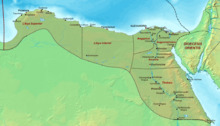| Provincia Arcadia Aegypti ἐπαρχία Αρκαδίας Αιγύπτου | |
|---|---|
| province of the Roman Empire | |
| After 386–640s | |
 Diocese of Egypt, c. 400 | |
| Capital | Oxyrhynchus |
| History | |
• Established | After 386 |
• Disestablished | 640s |
| Today part of | |
Arcadia or Arcadia Aegypti was a Late Roman province in northern Egypt. It was named for one of the reigning augusti of the Roman Empire, Arcadius (r. 383–408) of the Theodosian dynasty when it was created in the late 4th century. Its capital was Oxyrhynchus and its territory encompassed the Arsinoite nome and the "Heptanomia" ("seven nomes") region.[1]
History
It was created between 386 and ca. 395 out of the province of Augustamnica and most of the historical region known as "Heptanomis" ("seven nomes"), except for Hermopolis, which belonged to the Thebaid.[2]
In the Notitia Dignitatum, Arcadia forms one of six provinces of the Diocese of Egypt, under a governor with the low rank of praeses.[2][3]
By 636, the praeses governor had been replaced by a governor with the rank of dux.[1]
Episcopal sees
Ancient episcopal sees in the Roman province of Arcadia Aegypti, listed in the Annuario Pontificio as titular sees:[4]
- Oxyrhynchus, the Metropolitan Archbishopric, so probably the provincial capital
- Alphocranon (Helwan)
- Aphroditopolis (Atfih)
- Arsinoë in Arcadia (Faiyum)
- Cynopolis in Arcadia (El-Queis? Cheikh-Fadl?)
- Heracleopolis Magna
- Memphis
- Nilopolis
- Theodosiopolis in Arcadia (Taha-el-Amudein)
References
- ^ a b Keenan, James (2018), Nicholson, Oliver (ed.), "Arcadia", The Oxford Dictionary of Late Antiquity (online ed.), Oxford University Press, doi:10.1093/acref/9780198662778.001.0001/acref-9780198662778-e-388, ISBN 978-0-19-866277-8, retrieved 2020-12-29
- ^ a b Keenan (2000), p. 613
- ^ Notitia Dignitatum, in partibus Orientis, I
- ^ Annuario Pontificio 2013 (Libreria Editrice Vaticana 2013 ISBN 978-88-209-9070-1), "Sedi titolari", pp. 819-1013
Sources
- Keenan, James K. (2000). "Egypt". In Cameron, Averil; Ward-Perkins, Bryan; Whitby, Michael (eds.). The Cambridge Ancient History, Volume XIV - Late Antiquity: Empire and Successors, A.D. 425–600. Cambridge University Press. pp. 612–637. ISBN 978-0-521-32591-2.